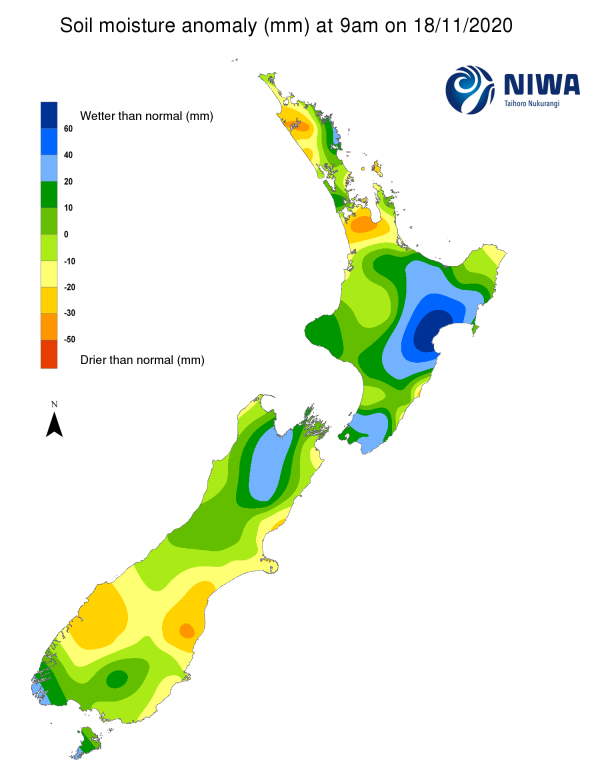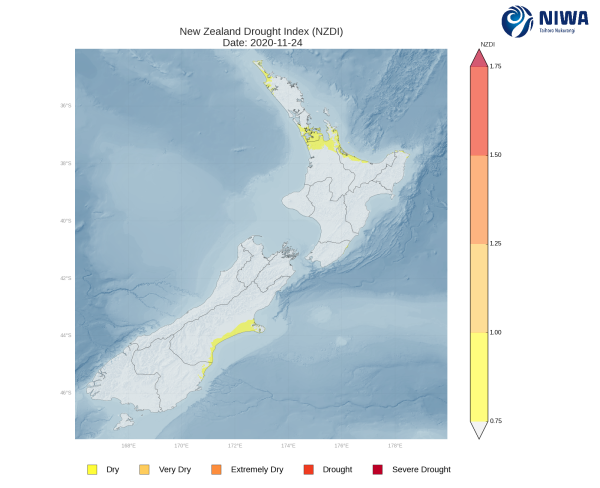A weekly update describing soil moisture patterns across the country to show where dry to extremely dry conditions are occurring or imminent. Regions experiencing significant soil moisture deficits are deemed “hotspots”. Persistent hotspot regions have the potential to develop into drought.
Facts: Soil Moisture
Substantial rainfall amounts of 50 mm or more were observed across much of the western and central North Island during the past week, with a few isolated pockets of 100 mm. Along the east coast, amounts were generally 25-40 mm, while Northland and Auckland generally received less than 25 mm. This resulted in moderate to large soil moisture increases across the lower two-thirds of the North Island. Conversely, small to moderate soil moisture decreases were observed in Northland, Auckland, the Coromandel Peninsula, and East Cape. The driest soils across the North Island, when compared to normal for this time of the year, are now found in the Far North. Meanwhile, the wettest soils for this time of the year are located in Hawke’s Bay.
In the past week a new hotspot has formed on the Aupouri Peninsula.
In the South Island, small parts of Kaikoura, eastern Marlborough, Tasman, and Banks Peninsula received 30-60 mm of rain in the past week, along with the lower West Coast and Fiordland. However, the large majority of the South Island received 25 mm or less. Small soil moisture increases occurred in the top of the South Island, while small to moderate decreases were generally observed elsewhere. The driest soils in the South Island compared to normal for this time of the year are now located in lower Westland, while the wettest soils for this time of the year are found in the vicinity of Nelson.
A hotspot is currently found from around Timaru south to coastal Waitaki District.
Outlook and Soil Moisture
High pressure will bring dry weather to the North Island on Saturday before showers impact mostly western and southern portions of the island on Sunday. An area of low pressure will bring more widespread rainfall on Monday and early Tuesday (30 Nov-1 Dec), with many areas receiving 20-40 mm. However, smaller rainfall amounts are expected in the upper North Island. After a dry day on Wednesday, a few showers may occur on Thursday. Weekly rainfall totals may reach 30-50 mm in the western and southern North Island, with up to 25 mm in most other areas. However, parts of Auckland and Northland may only receive 15 mm or less.
Due to the expected rainfall over the next week, the central and southern North Island will likely see either little change in soil moisture or slight increases. However, soil moisture decreases are most likely in Northland and Auckland. This will result in a strengthening of the current hotspot in the Far North.
Saturday will be mostly dry in the South Island before some rain affects the West Coast overnight. An area of low pressure will deliver widespread rainfall to the top half of the South Island on Monday (30 November), with amounts of 15-30 mm possible. High pressure will bring dry conditions on Tuesday before heavy rain possibly impacts the West Coast on Wednesday (2 December). Weekly rainfall totals may reach up to 75 mm along the West Coast, with up to about 40 mm in the top of the South Island. However, rainfall amounts in southern Canterbury and coastal Otago may only reach 15 mm or less.
Some soil moisture increases may be found in the West Coast and upper South Island during the next week, but additional decreases will be most likely in southern Canterbury and coastal Otago. This will likely result in strengthening and expansion of the hotspot located there.
Background:
Hotspot Watch: a weekly advisory service for New Zealand media. It provides soil moisture and precipitation measurements around the country to help assess whether extremely dry conditions are imminent.
Soil moisture deficit: the amount of water needed to bring the soil moisture content back to field capacity, which is the maximum amount of water the soil can hold.
Soil moisture anomaly: the difference between the historical normal soil moisture deficit (or surplus) for a given time of year and actual soil moisture deficits.
Definitions: “Extremely” and “severely” dry soils are based on a combination of the current soil moisture status and the difference from normal soil moisture (see soil moisture maps).
Hotspot: A hotspot is declared if soils are "severely drier than normal" which occurs when Soil Moisture Deficit (SMD) is less than -110 mm AND the Soil Moisture Anomaly is less than -20 mm.
Pictured above: Soil Moisture Anomaly Maps, relative to this time of year. The maps show soil moisture anomaly for the past two weeks.
New Zealand Drought Index (NZDI)
As of 24 November, the New Zealand Drought Index (NZDI) map below shows that drier than normal soils are located in a few areas, but meteorological drought is not currently found in New Zealand. Please note: some hotspots in the text above may not correspond with the NZDI map. This difference exists because the NZDI uses additional dryness indices, including one which integrates the rainfall deficit over the past 60 days. Changes are therefore slower to appear in the NZDI compared to soil moisture anomaly maps that are instantaneously updated.




